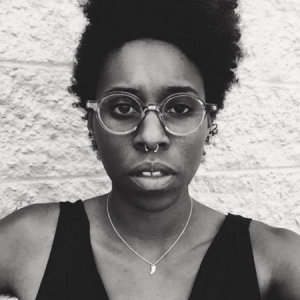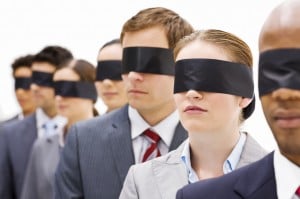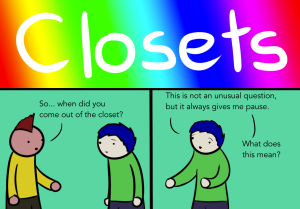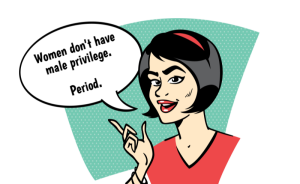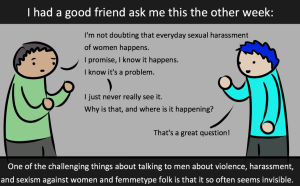(Content Warning: racist quotes, mention of anti-trans language)
The day of the Women’s March on Washington, my social media lit up with pictures of friends, students, and community members taking to the streets.
That day, millions of people marched to protest the inauguration and presidency of Donald J Trump. Even my mom sent me a hella cute text declaring herself a part of the sisterhood.
But while there was some beautiful solidarity, many divisions remain between white women and women of color.
There’s an ugly history of oppression within “Women’s Liberation” and the “Feminist Movement” that we must acknowledge before we can approach any meaningful alliance.
Thinkpiece after thinkpiece after thinkpiece explained why so many people of color refused to march on January 21st.
They raise point after valid point about racism within mainstream feminism.
Many of these writers reflect a desire for the movement to be more inclusive, to be more aware of its racial fault lines, and to be more of a coalition.
If anyone is out there reading this and saying “that sounds hard,” that’s because it is.
Black feminist Bernice Johnson Reagon once said that true coalition would make you feel as though you were “gonna keel over any minute and die…threatened to the core.” Indeed, coalition requires facing some hard truths about racism, transmisogyny, and cultural appropriation in the feminist movement.
Moreover, it involves action to mend feminism where it’s fallen by the wayside.
So here’s a consolidated list of steps for those white feminists who have read the critiques, raised their own awareness, and acknowledged their privilege.
Here’s what to do next.
1. Push Past Your Pride and Acknowledge Your Racism
Carrie Chapman Catt said,“White supremacy will be strengthened, not weakened, by women’s suffrage.”
Elizabeth Cady Stanton said, “What will we and our daughters suffer if these degraded black men…have the rights that would make them even worse than our Saxon fathers?”
I begin with these blatantly racist quotes because they give rise to one of – if not the greatest – challenge many organizers have faced historically and today when it comes to solidarity with white feminists: racism. These two quotes were not from rank-and-file suffragettes, but from founders of feminism.
Racism is perhaps the most obvious reason so many women and people of color keep two hands out for distance when it comes to mainstream feminism.
Despite studying feminism throughout college, I was years into my PhD before I learned the history of women of color feminists.
For instance, four short years ago, I learned that Native women of the Seneca nation taught Lucretia Mott about governmental structure and decision-making before she traveled to Seneca Falls, where she and Elizabeth Cady Stanton held the world’s first women’s rights convention.
The erasure of our labor and explicit white supremacy from white feminists persists in highly visible feminists like Amy Schumer and Lena Dunham whose “casual racism” invites not only divisiveness, but rancor.
In the this tweet, Schumer illustrates a repeated (and woefully common) willingness to demonize and criminalize men of color as needed to unite white women behind the fiction of the Black/Brown brute.
I need white feminists to acknowledge that they’re inviting people of color into a movement that has historically appropriated our labor and perpetuated white supremacy.
Recognizing that fact will go a long way in healing the divide between us.
2. Move Outside of Your Comfort Zones and Show Up
If you are able and have the capacity, now is the time to show up with your signs, your voices, and your bodies.
I live in a city where I see the same people at every single action. They’re at every bridge shut down. They chain themselves to every building. They’re at every town hall meeting.
We joke they’re the mayors of the town.
Unsurprisingly, they’re tired. They have day jobs, but their commitment to just being physically present is unrivaled.
I’m not saying you suddenly need to become the quintessential activist (such a thing doesn’t exist) or attend every organizing meeting. I actually discourage this because burnout is real. But by simply showing up, you are supporting anti-oppression in all its myriad forms.
Last month, thousands of people – many of them new to movement work – went to their second protest ever.
And do you know what happened?
All the detainees at airports in Los Angeles, Chicago, Philadelphia, and San Francisco were released.
If this new outpouring of enthusiastic support continued to fight for women’s rights, but also for the rights of Muslims, LGBTQIA+ folks, Native, and Black communities, we could change the face of oppression.
So show up however you can.
Open your wallet and donate. If you work in tech, learn how to help us protect ourselves with cyber security. Or do any of these 26 things.
I do believe that we will win, but only if a lot of us take the time to show the fuck up.
3. Pass the Mic – And Take Notes
Over three million people marched the day after the inauguration.
Many of them had never before participated in any sort of civil disobedience.
I believe one of the greatest challenges facing us right now is the conflict between the righteousness of the novice and the impatience of the veteran. That is to say, just because you went to one march doesn’t make you an expert.
But then again, neither does going to every protest on the planet.
We have a lot to learn from each other, but especially for those folks who are new to organizing and social justice work. Now is a great time to learn from people who have been doing this for years, decades, lifetimes.
When I was at the San Francisco airport protest, I witnessed someone facilitate a people’s mic better than anyone I had ever seen. So I didn’t try to be heard. I didn’t try to take up space. I took notes.
All of the organizers I look up to have one thing in common: They listen first.
Now is the time to make space, be humble, and learn. If we do that, we can grow as better, badder, and more effective creators of social change.
4. Stop Calling Everyone a Pussy
You don’t sound tough. You sound trans-averse.
A few weeks ago, I was published in a weekly newspaper.
It was titled, to my chagrin, “Pussy Grabs Back.” The issue was all about new resistance movements, but the cover was upsetting to me because I know tons of women doing amazing feminist work.
They fight sexual assault, rape, and sexism, but none have pussies.
If we continue to conflate women, feminism, and vaginas, we risk the same kind of exclusion, erasure, and transmisogyny that plagues other mainstream movements.
There’s a popular belief that the “Gay Liberation Movement” began with the Stonewall Riots in New York. Yet the recent film immortalizing it left out two of the most important people in the riot, both trans women of color.
Marsha P. Johnson, who “really started it,” and Sylvia Rivera, who said, famously, “I will not put up with this shit,” were left conspicuously out of the film.
Rampant anti-queer sentiments and transmisogyny in mainstream movements, and even the films depicting them, prevent many queer and trans folks from aligning with feminism.
If we truly want our movement to include every single body, we need to work on our language and our visual cues.
We may not all have pussies, but we’re all fighting back.
5. Accept That Our No Is the Consequence of Years of Feminist Exclusion
I was born a feminist.
The kind the Crunk Feminist Collective calls “Mama’s Feminism” – that is, feminism not by name, but action. My mother, a refugee, raised me on her own. It’s lineages like hers that resonate the strongest with me.
I’m from a long line of incomparable women. Women like the Trung sisters, who, as early as 40 AD, gathered an army of 80,000 people to help drive the Chinese from their lands. They selected 36 women, including their mother, to be generals. They led a people’s army to drive the Chinese out of Viet Nam.
I recognize the work of women like Maria Stewart who was the first woman to speak publicly against slavery.
Stewart proclaimed that she was called by divine energy to address the issues of Black emancipation and the rights of Black women. “We claim our rights,” she asserted, “as women and men, and we are not afraid of them that kill the body.”
I locate my ancestral strength in women like Gabriela Silang, who was the first documented female freedom fighter to resist the Spanish occupation of the city of Vigan in the Illokandia region in the 18th century. After her husband and famous rebel fighter was killed, Silang took the reigns as the rebellions commander-in-chief.
But mainstream white feminism neither acknowledges nor celebrates these women, my ancestors.
Perhaps, even worse, it often fails to see our work of prison abolition, fighting for undocumented communities, or trans liberation as part of feminism.
So many of us have been burned by feminism that we’ll never identify with this movement.
Accept that not everyone is a feminist. Accept that not everyone needs to be a feminist.
***
Even though we aren’t an explicit part of your movement, we will continue the work of fighting for collective freedom alongside you. Ultimately, isn’t that the whole point?
Before the event itself, the Women’s March on Washington released a set of unity principles. Alongside the well-tread feminist axiom that “women’s rights are human rights,” there were explicit calls for equity of people of all colors, including disabled, LGBTQIA+, and immigrant communities.
The statement was beautiful, profound, and intersectional.
It was also aspirational.
We all have a long way to go, many white feminists in particular. My hope is that by shedding some light on the path ahead, we can all work toward it.
Together.
[do_widget id=’text-101′]
Kim Tran is a Contributing Writer for Everyday Feminism. She’s also a collective member of Third Woman Press: Queer and Feminist of Color publishing. Her academic and activist commitments are to laborers, refugee and queer communities. She is finishing her Ph.D in Ethnic Studies at UC Berkeley where writes on race, gender, and economics. Her work has been featured on Black Girl Dangerous, Nation of Change and the Feminist Wire. She can be found in any of these capacities at her website. Read her articles here.
Search our 3000+ articles!
Read our articles about:
Our online racial justice training
Used by hundreds of universities, non-profits, and businesses.
Click to learn more






